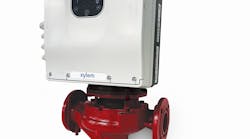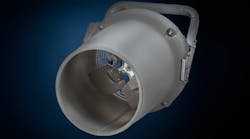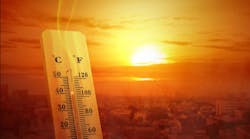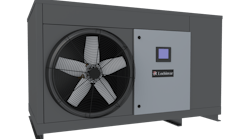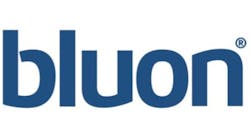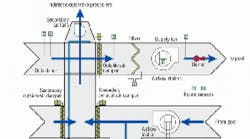Operated by the Marathon Area Swim Association (MASA), the Ray & Marie Goldbach, Marathon Area Swim Center in Marathon, Wis., is a 10,122-sq-ft facility consisting of a 25-yd-long, six-lane-wide main pool; a small instructional pool; locker rooms; and a small administrative area. It opened in 1988.
The original pool dehumidification unit (DHU) used heat of rejection from the refrigeration system to heat pool water and provide hot-gas reheat. In 2003, it began experiencing operational problems. Those problems became severe in early 2004. The temperature controls failed because of corrosion, causing the service contractor to alter the way the system was controlled. The dehumidification-system condenser lost its ability to heat the pools' water. The cooling-coil fins became oxidized and started to fall off. The hydronic heating coil froze and ruptured on several occasions. By 2009, the unit housing had lost integrity, and MASA concluded it needed to replace the system.
The system MASA chose (IDECVAV) is a direct-fired, variable-volume, 100-percent-outdoor-air unit equipped with an indirect evaporative precooler used to provide sensible cooling and heating-season energy recovery (Figure 1). The system is installed on the roof of the building, where it is subject to winter design conditions of -25°F.
This article compares the performance of the original and replacement systems. The comparison is based on actual performance. Aiding the comparison is the fact the swim center is a stand-alone facility served by dedicated utilities, rather than a small part of a much larger facility without dedicated utilities or submetering, which can obscure, distort, or dilute actual performance.
Strategies
The DHU introduced minimum outdoor air through the mixed-air path. This concept treats ventilation energy as a tax on the system the owner simply must pay. Refrigeration was used to dehumidify the air. Rejected heat was used to heat supply air and pool water. Recirculation of chloramine-contaminated air caused equipment deterioration and, ultimately, failure. The use of refrigeration for pool-water heating, while more economical than the brute-force use of water heating and ventilation, reduced energy usage, but imposed high parasitic energy losses on the system in the form of compressor energy.
The IDECVAV system is ventilation-based and designed with the following features:
- Outdoor air is free of chloramines and dry under cold weather conditions. The design employs 100-percent outdoor air to maximize air quality. Also, it permits the equipment to be located outdoors, prevents moisture from compromising air-handling-unit insulation during cold-weather operation, allows adjacent areas to be pressurized with fresh air, and limits the potential for corrosion damage.
- Supply-air volume is controlled to maintain space relative humidity with a low limit set to the minimum-outdoor-air ventilation rate.
- The exhaust fan is a direct-drive plug fan that locates the motor outside of the corrosive air stream. Exhaust airflow is piezometrically tracked to supply airflow to maintain mass balance and a pressure consistent with that of adjacent spaces. Secondary-exhaust-fan speed is slaved to primary-exhaust-fan speed to maintain building pressure under all conditions of operation.
- Exhaust-air, secondary exhaust-air, and secondary outdoor-air dampers are modulated as a mixed-air control.
- The system is designed around an indirect evaporative cooler. The air-to-air heat exchanger is of polymer construction to resist corrosion. The housing is American Iron and Steel Institute Type 304 stainless steel for corrosion resistance. Cooling, on the rare occasions it is needed, is provided by cycling the indirect-evaporative-cooler pump on and off.
- Supplemental heat is provided through a direct-fired gas burner with a 40:1 turndown ratio to maximize fuel efficiency.
With the IDECVAV system, outdoor-air ventilation is used to control space relative humidity and always is provided in quantities that meet or exceed minimum code requirements. Energy is conserved by recovering sensible and latent energy from exhaust air to temper outdoor air. Because much of the energy in the exhaust path is recovered and recycled, the need for refrigeration—and the associated high parasitic energy use—is functionally eliminated.
Figure 2 shows the psychrometric path in heating mode. Both sensible and latent heat (A-B) are converted to sensible heat (X-Y) through energy recovery. Supplemental heat is introduced by a gas burner (Y-Z). Water vapor is absorbed from the space while heat is delivered to offset envelope losses (Z-A). In part because system airflow is controlled from space relative humidity, an 8,760-hr typical-meteorological-year psychrometric analysis was employed not only to predict system economics, but to eliminate uncertainty as to which ambient conditions would dictate design airflow rates and to determine which conditions produce both maximum heating and maximum cooling requirements.
The performance of an air-to-air heat exchanger is amplified when moisture condenses on or evaporates from the heat-exchanger surface. This causes boundary-layer resistance to heat transfer to break down. The increased efficiency can become a serious problem at very low ambient conditions. In this application, however, the potential is much reduced, as long as the air in the exhaust path has sufficient energy to prevent the formation of ice in the heat exchanger. For a pool system, that generally is possible if design space-temperature and relative-humidity conditions are maintained. At low-ambient-temperature conditions, that can be compromised by the use of pool covers.
Performance Comparison
The utility use of the DHU in 2003, the last year the DHU was able to perform as designed, was compared with the utility use of the IDECVAV system from July 2010 through June 2011. Both data sets are imperfect: The DHU experienced a shutdown in March 2003; the IDECVAV system had some unresolved startup issues and experienced an unusually cold spring in 2011. However, by any measure, the performance gains realized by the IDECVAV system were significant.
Figure 3 shows aberrations in the DHU’s natural-gas utility use from January to March 2003, when operational problems began. The IDECVAV system substituted less expensive natural gas for the benefits of the electrically driven refrigerant compressors in the DHU. As a result, natural-gas use for all purposes increased 33.7 percent, from 15,842 therms with the DHU in 2003 to 23,951 therms with the IDECVAV system in 2011.
Figure 4 shows an aberration in the DHU’s electricity use in March 2003. Both systems demonstrate relatively flat electricity-use profiles; however, the IDECVAV system produced substantial reductions: Electricity use for all purposes decreased 58.8 percent, from 776,373 kwh with the DHU in 2003 to 319,641 kwh with the IDECVAV system in 2011. Total combined energy use dropped 17.7 percent, from 455,602 Btu per square foot per year with the DHU to 375,122 Btu per square foot per year with the IDECVAV system (Figure 5). Annual greenhouse-gas emissions dropped 44.6 percent, from 614 to 340 metric tons of carbon dioxide.
Figure 6 shows relative energy costs based on 2011 prices. The DHU’s natural-gas costs are $10,268, while the IDECVAV system’s are $15,525. The $5,257 difference is more than offset by the difference in electricity costs: The DHU’s electricity costs are $54,000.02, while the IDECVAV system’s are $22,145, a difference of $31,855. The net reduction in total energy costs with the IDECVAV system is $26,598, or 41.4 percent.
On a dollars-per-square-foot-of-facility basis, annual energy costs are $4.05 with the IDECVAV system vs. $6.92 with the DHU. On the more reliable dollars-per-square-foot-of-pool-area basis, energy costs are $11.54 with the IDECVAV system vs. $19.68 with the DHU.
Conclusions
Certain aspects of the IDECVAV strategy employed at the Ray & Marie Goldbach, Marathon Area Swim Center, such as the use of an indirect evaporative precooler as both the primary energy-recovery device and the primary cooling system, may seem counterintuitive. However, the efficiency and indoor-air-quality advantages over the dehumidifier solution are significant. Better energy performance comes from the fact that while both act to recover the latent and sensible heat in the pool area, the ventilation-based IDECVAV solution is able to provide them passively, without the need to operate refrigerant compressors.
By all measures, the IDECVAV system outperformed the DHU. It provides superior air quality under most conditions of operation, is less complex, is of more durable construction, consumes less energy, costs substantially less to operate, and reduces greenhouse-gas emissions. Because it uses no hydrofluorocarbons, chlorofluorocarbons, or hydrochlorofluorocarbons, it also is much "greener." Perhaps most importantly, it is affordable. The system costs less to install and can pay for itself quickly with reduced energy costs in retrofit applications.
SIDEBAR: IMPACT OF CONTROL PRECISION AND OPERATING CONDITIONS ON COSTS
Swimming pools present unique and substantial challenges to HVAC designers. Occupancy loads are negligible compared with dehumidification loads. While thermal control is important, the precision of humidity control is what drives energy use and ventilation requirements.
Swimming-pool energy use consists of four interrelated components: pool-water heating, ventilation/dehumidification, envelope heating loads, and systemic inefficiencies. Indoor design conditions mimic summer outdoor design conditions. Sensible cooling loads usually are minimal and rarely a consideration in design. Dehumidification and pool-water heating loads are driven by evaporation rates, which are a function of water-surface area and the difference in vapor pressure between water and air.
Air quality. Air quality in swimming-pool installations is driven by pool-water quality. Chemical treatment, usually a form of chlorine, typically is required by health departments to control microorganisms and neutralize metabolic wastes in pool water. Chlorine oxidizes ammonia, a common metabolic-waste byproduct, to form the combined chlorine compounds monochloramine (NH3Cl), dichloramine (NH2Cl2), and trichloramine (NHCl3). These compounds are what produce a strong “chlorine” odor in pools and are noxious, toxic, and corrosive. Being heavier than air, chloramines tend to concentrate in the lower 12 in. of a space, in pool occupants’ respiration zone. This necessitates the exhaust of air at floor level.
Chloramines corrode ferrous materials, copper, and aluminum in HVAC systems. They attack copper pipes, electrical circuits, and printed circuit boards used to control HVAC and pool systems. Where air is recirculated, they can cause the rapid deterioration of galvanized-steel ducts.
Recirculation of pool air creates a cycle of concentration that increases background chloramine concentrations until the rate of generation equals the rate of removal by exhaust.
Design objectives. While minimum rates of ventilation are required to limit adverse effects on occupant health, greater-than-minimum rates are desirable when economically viable. One-hundred-percent outdoor air provides the additional advantage of preventing the supply sides of HVAC ductwork, equipment, and controls from being exposed to chloramines. Because it holds very little moisture during cold weather, 100-percent outdoor air also prevents condensation on the supply side of equipment located outdoors in cold weather. Additionally, it breaks the cycle of concentration that occurs when pool air is recirculated.
The amount of outdoor air required to maintain space humidity is dependent on the amount of moisture in the air. Varying outdoor-air volume as required to control humidity is an effective way to satisfy ventilation requirements and displace chloramines.
For purposes of both energy conservation and swimmer comfort, the most desirable space conditions for pool ventilation systems are warm and humid. High levels of air motion create drafts, while low relative humidity increases the rate of evaporation from a swimmer's body, causing discomfort. For athletic events, water temperature of 81°F to 82°F is preferred. For therapeutic pools, water temperature of 85°F to 87°F is preferred. For spas, water temperature of 104°F to 106°F is preferred.
Pool-water heating loads are driven almost exclusively by evaporation. Figure 7 illustrates the energy implications of small deviations in operating temperature, humidity, and pool-water temperature for a 5,000-sq-ft swimming pool.
Evaporation is driven by the difference in vapor pressure between pool water and air. Vapor pressure in water is a function of water temperature, while vapor pressure in air is a function of air temperature and relative humidity. As the vapor-pressure differential between air and water increases, so does evaporation and energy use. For example, a 4°F reduction (from 82°F to 78°F) in water temperature, a 4°F increase (from 83°F to 87°F) in air temperature, and a 10-percent increase (from 50 percent to 60 percent) in relative humidity effectively reduces pool energy use by 65 percent, from 836 MBH to 296 MBH.
The president of Lentz Engineering Associates Inc. (www.lentzengineering.com) and a member of HPAC Engineering’s Editorial Advisory Board, Mark S. Lentz, PE, is nationally recognized for having successfully developed, tested, and proven several advanced HVAC-system strategies designed to exceed the performance requirements of ANSI/ASHRAE/IESNA Standard 90.1, Energy Standard for Buildings Except Low-Rise Residential Buildings, while meeting or exceeding the requirements of ANSI/ASHRAE Standard 62.1, Ventilation for Acceptable Indoor Air Quality. He is the recipient of numerous national engineering awards, including an American Society of Heating, Refrigerating and Air-Conditioning Engineers (ASHRAE) Energy Award, an ASHRAE Symposium Paper of the Year Award, and an ASHRAE Distinguished Service Award.
Did you find this article useful? Send comments and suggestions to Executive Editor Scott Arnold at [email protected].



